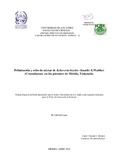Mostrar el registro sencillo del ítem
Polinización y robo de néctar de Echeveria bicolor (Kunth) E.Walther (Crassulaceae) en los páramos de Mérida, Venezuela.
| dc.rights.license | http://creativecommons.org/licenses/by-nc-sa/3.0/ve/ | |
| dc.contributor.advisor | Soriano, Pascual J. | |
| dc.contributor.author | Lugo Moreno, Libardo | |
| dc.date.accessioned | 2017-01-31T15:27:43Z | |
| dc.date.available | 2017-01-31T15:27:43Z | |
| dc.date.issued | 2016-03-29 | |
| dc.identifier.uri | http://www.saber.ula.ve/handle/123456789/42939 | |
| dc.description | Cotutora: Pelayo, Roxibell del C. roxibell@ula.ve | es_VE |
| dc.description.abstract | En el sistema planta-polinizador se generan procesos coevolutivos que permiten optimizar las interacciones entre sus componentes; las flores de la crasulácea Echeveria bicolor poseen atributos que concuerdan con las descritas para una evolución conjunta con colibríes de pico corto. El objetivo de este estudio fue evaluar en el Páramo Andino algunos aspectos de la ecología de la polinización de E. bicolor y el efecto de los robadores de néctar. Encontramos que hay cuatro especies de aves asociadas a las flores de E. bicolor, de las cuales tres son colibríes, y la otra, un ave robadora de néctar. Entre los colibríes visitantes, calificamos a M. tyrianthina como el polinizador principal, debido a que es el único con pico corto, lo cual le permite visitar las flores y transportar el polen con comodidad; además, fue la especie que realizó el mayor número de visitas (>93%). Las flores de E. bicolor, a pesar de ser hermafroditas y autocompatibles, exhiben mecanismos que promueven la fecundación cruzada, tales como, asincronía en la maduración de los órganos reproductivos (hercogamia temporal) y abundante producción de néctar; además, los robadores no comprometen la reproducción de la especie ya que que no destruyen las estructuras reproductivas de la planta. | es_VE |
| dc.language.iso | es | es_VE |
| dc.rights | info:eu-repo/semantics/openAccess | |
| dc.title | Polinización y robo de néctar de Echeveria bicolor (Kunth) E.Walther (Crassulaceae) en los páramos de Mérida, Venezuela. | es_VE |
| dc.type | info:eu-repo/semantics/bachelorThesis | |
| dc.description.abstract1 | In the plant-pollinator system, coevolutionary processes that could optimize the interactions between its components are generated; flowers of Echeveria bicolor have attributes that match to those described for a concerted evolution with short-beaked hummingbirds. The aim of this study was to evaluate in the Andean Paramo some aspects of the pollination ecology of E. bicolor and the effect of nectar robbers. We found that there are four species of birds associated with E. bicolor’s flowers, three of which are hummingbirds, and the other one, a nectar-stealing bird; among visitor hummingbirds, we qualify M. tyrianthina as the main pollinator because it is the only one with a short beak, which allows it visiting flowers and carrying pollen comfortably; it also was the species that made the most visits (> 93%). E. bicolor flowers, despite being hermaphroditic and self-compatible, exhibit mechanisms that promote cross-pollination, such as asynchrony in maturation of the reproductive organs (temporary herkogamy) and abundant nectar production; we also found that nectar robbers do not compromise reproduction of the species since they do not destroy the plant’s reproductive structures. | es_VE |
| dc.description.email | pascual@ula.ve | es_VE |
| dc.description.grado | Licenciado en Biología | |
| dc.publisher.pais | Venezuela | es_VE |
| dc.subject.departamento | Departamento de Biología | es_VE |
| dc.subject.facultad | Facultad de Ciencias | es_VE |
| dc.subject.institucion | Universidad de Los Andes | es_VE |
| dc.subject.thematiccategory | Biología | es_VE |
| dc.subject.tipo | Tesis | es_VE |
| dc.subject.unidadinv | Instituto de Ciencias Ambientales y Ecológicas (ICAE) | es_VE |
| dc.type.media | Texto | es_VE |
Ficheros en el ítem
Este ítem aparece en la(s) siguiente(s) colección(ones)
-
Tesis de Pregrado (Facultad de Ciencias)
-
Tesis de Pregrado (Instituto de Ciencias Ambientales y Ecológicas (ICAE))
Tesis de Pregrado del Instituto de Ciencias Ambientales y Ecológicas (ICAE)


